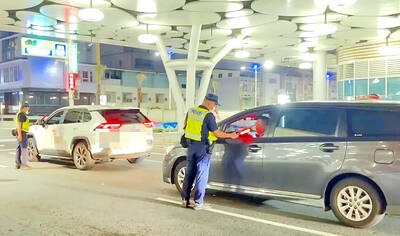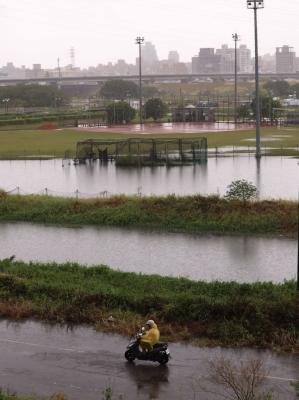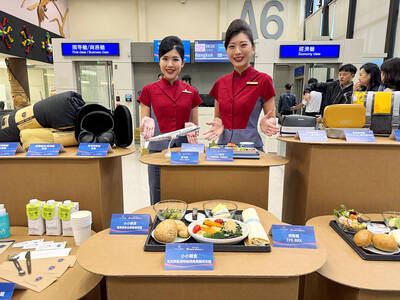Nantou County’s Puli Township (埔里) had the highest increase in PM2.5 levels over the past four years, while Kaohsiung’s Zuoying District (左營) had the highest PM2.5 concentration, according to a “yearbook” published yesterday by the Taiwan Healthy Air Action Alliance, chronicling air pollution levels from 2012 to last year.
PM2.5 — fine particulate matter measuring 25 micrometers or less that is small enough to penetrate the deepest parts of lungs — was recognized as one of the Environmental Protection Administration’s (EPA) air quality indices in 2012.
The alliance analyzed the data from the EPA’s 76 air quality monitoring stations and found that Puli had the highest PM2.5 increase, as the township’s average PM2.5 levels rose from 30 micrograms per cubic meter in 2012 to 35.6 micrograms per cubic meter last year.
Puli was followed by Dongshan Township (冬山) in Yilan, Tucheng District (土城) in New Taipei City, Erlin Township (二林) in Changhua and Linkou District (林口) in New Taipei City, with each having 4.3 micrograms, 4.2 micrograms, 4.1 micrograms and 3.5 micrograms per cubic meter increases in PM2.5 levels respectively.
Kaohsiung was found to have the heaviest concentration of PM2.5 in the air, as the city’s Zuoying (左營), Cianjin (前金), Siaogang (小港) and Cianjhen (前鎮) districts were the top four locations with the highest PM2.5 concentrations in the past three years.
Only four monitoring stations had PM2.5 levels lower than the EPA’s limit of 15 micrograms per cubic meter: one in Yangmingshan National Park in Taipei, one in Kenting National Park in Pingtung County and two in Taitung County.
Many of the EPA’s air monitoring stations have recorded increasing PM2.5 levels despite the EPA’s claim that national PM2.5 levels have decreased by 20 percent since 2008, which suggests that the agency’s PM2.5 control measures should be improved, alliance convener and Changhua Christian Hospital gynecologist Yeh Guang-peng (葉光芃) said.
Kinmen County had a 38.7 percent decrease in PM2.5 levels from 2008 to last year, compared with the 20.3 percent decrease in Taiwan proper. However, 96 percent of Kinmen’s air pollutants come from outside the county, mostly from China, Yeh said, asking why the levels in Taiwan proper saw less improvement than those in Kinmen, which is affected by China.
Yeh said he was hesitant to link the contrast between Kinmen and Taiwan proper to different methods of pollution control measures employed in China and Taiwan, adding that the government should face the domestic pollution issue instead of blaming China for pollution.

TRAFFIC SAFETY RULES: A positive result in a drug test would result in a two-year license suspension for the driver and vehicle, and a fine of up to NT$180,000 The Ministry of Transportation and Communications is to authorize police to conduct roadside saliva tests by the end of the year to deter people from driving while under the influence of narcotics, it said yesterday. The ministry last month unveiled a draft of amended regulations governing traffic safety rules and penalties, which included provisions empowering police to conduct mandatory saliva tests on drivers. While currently rules authorize police to use oral fluid testing kits for signs of drug use, they do not establish penalties for noncompliance or operating procedures for officers to follow, the ministry said. The proposed changes to the regulations require

The Executive Yuan yesterday announced that registration for a one-time universal NT$10,000 cash handout to help people in Taiwan survive US tariffs and inflation would start on Nov. 5, with payouts available as early as Nov. 12. Who is eligible for the handout? Registered Taiwanese nationals are eligible, including those born in Taiwan before April 30 next year with a birth certificate. Non-registered nationals with residence permits, foreign permanent residents and foreign spouses of Taiwanese citizens with residence permits also qualify for the handouts. For people who meet the eligibility requirements, but passed away between yesterday and April 30 next year, surviving family members

Taipei, New Taipei City, Keelung and Taoyuan would issue a decision at 8pm on whether to cancel work and school tomorrow due to forecasted heavy rain, Keelung Mayor Hsieh Kuo-liang (謝國樑) said today. Hsieh told reporters that absent some pressing reason, the four northern cities would announce the decision jointly at 8pm. Keelung is expected to receive between 300mm and 490mm of rain in the period from 2pm today through 2pm tomorrow, Central Weather Administration data showed. Keelung City Government regulations stipulate that school and work can be canceled if rain totals in mountainous or low-elevation areas are forecast to exceed 350mm in

China Airlines Ltd (CAL) yesterday morning joined SkyTeam’s Aviation Challenge for the fourth time, operating a demonstration flight for “net zero carbon emissions” from Taiwan Taoyuan International Airport to Bangkok. The flight used sustainable aviation fuel (SAF) at a ratio of up to 40 percent, the highest proportion CAL has achieved to date, the nation’s largest carrier said. Since April, SAF has become available to Taiwanese international carriers at Taipei International Airport (Songshan airport), Kaohsiung International Airport and Taoyuan airport. In previous challenges, CAL operated “net zero carbon emission flights” to Singapore and Japan. At a ceremony at Taoyuan airport, China Airlines chief sustainability